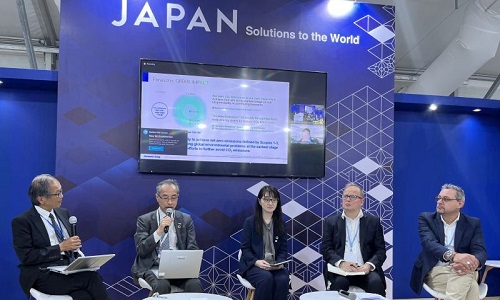Panasonic Shares Its Contributions to Net Zero through Panasonic GREEN IMPACT and Advocates for Importance of “Avoided Emissions” at COP27
Panasonic Group took part in COP27 and reaffirmed its aim to help re-design global economies and realize carbon neutrality through contributing to avoided emissions with hydrogen and the circular economy. The company showcased to a global audience the importance of hydrogen and the circular economy as critical aspects of achieving avoided emissions and a self-sustaining and secure energy future.
Panasonic’s participation at the global summit reflects its strong commitment to achieving a sustainable future by advancing the company’s long-term environmental vision, “Panasonic GREEN IMPACT”. Under this vision, the group aims to reduce CO2 emissions from its operations to virtually net zero by 2030 and to create an impact that reduces CO2 emissions by more than 300 million tons, approximately 1% of current total global emissions, by 2050.
A key part of reducing CO2 emissions is “avoided emissions,” or emissions reductions achieved through adoption of a company’s products or services. Panasonic Holdings Corporation CTO Tatsuo Ogawa touched on this topic during a high-level sector panel discussion on mitigation contributions for achieving both economic growth and emissions reduction that was hosted by METI and MOE at the Japan Pavilion. He spoke about the background and purpose of Panasonic GREEN IMPACT, the importance of avoided emissions in reaching net-zero, and challenges that the concept poses. Participants also discussed how to establish a method to accurately measure avoided emissions, thereby ensuring transparency and credibility, and positioning the concept as an opportunity for meaningful corporate evaluation.
One specific example of Panasonic’s contributions to avoided emissions is its hydrogen energy technology. The company has been researching this technology for more than 20 years and has made household fuel cells readily available in the Japanese market. Today, nearly 400,000 Japanese homes use Ene-Farm, a fuel cell that utilizes hydrogen, with Panasonic accounting for roughly half of the installed units. Further practical examples exhibited at the Japan Pavilion include Panasonic’s RE100 solution, which utilizes pure hydrogen fuel cells that provide energy to cover all the necessary energy used in the business activities from renewable energy sources, and introduction of RE100 solution demonstration facility at the company’s plant in Kusatsu, which has been in operation since April of this year.
“If we are to secure the future of our planet, then we have to look at means to achieve carbon neutrality. If we are to see a global green transformation, then capabilities like Panasonic’s fuel cell technology will definitely help economies and societies transform and increase adaptability and achieve sustainability. The time to act is now and the entire ecosystem, be it government, companies or global citizens, must align to secure our planet,” said Mr. Ogawa.
Another vital aspect of reducing CO2 emissions is the promotion of the circular economy. On November 17, Panasonic Group senior fellow Wataru Baba took the stage at a seminar organized by the Ministry of the Environment on the importance of resource recycling in decarbonization. Panelists from government agencies in various countries and related global organizations discussed the role of the private sector in building sustainability into the supply chain to achieve a “circular, carbon-neutral economy.” As a specific example of efforts towards a circular economy, Baba shared the Group’s new business model for EV batteries in the U.S., officially announced that week. He mentioned that Panasonic Energy Co., Ltd., a Panasonic Group Company, recently entered into an agreement with a local North American company to purchase recycled cathode active materials and copper foil. These materials are vital for the efficient and safe operation of EV batteries and as the materials provided by Redwood are recycled, this will make a significant contribution to a circular economy in the Group’s production of EV batteries.
The 27th UN Climate Change Conference COP27 took place against the backdrop of inadequate ambition to curb greenhouse gas emissions. According to the UN’s Intergovernmental Panel on Climate Change, CO2 emissions need to be cut by 45% by 2030 relative to 2010 levels to meet the central Paris Agreement goal of limiting temperature rise to 1.5 degrees Celsius by the end of this century. This is crucial to avoid the worst impacts of climate change, including more frequent and severe droughts, heat waves, and rainfall.
Through its participation in COP27 and promotion of Panasonic GREEN IMPACT, Panasonic was able to advocate widely for further recognition of the concept of avoided emissions, and at the same time, shape the discussion alongside the many countries and related organizations that joined, hopefully paving the way for further recognition of avoided emissions and a boost to global CO2 emissions reductions efforts.
Source: Panasonic


